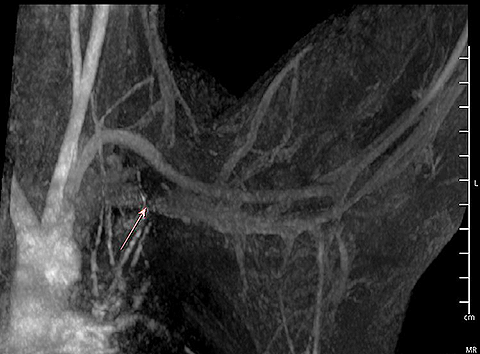Hope & Health
Articles and Updates from WVU Medicine Golisano Children's
01/4/2024 | P. David Adelson, MD
So, Your Doctor Doesn’t Believe Your Arm Tingles When You Raise It?
A teenage swimmer, who was having difficulties with her pool workouts, came to see me. When she raised her arms above her head, they would begin to get numb. Exams, x-rays, and tests performed by other physicians were normal. They kept telling her they couldn’t find anything wrong with her. I asked her to recreate the motions that made her symptoms occur.
When she lifted her arms for a minute or two, she began to complain of a “pins and needles” feeling in her fingers, particularly her ring and pinkie fingers, and a change of temperature in her arms. When she lowered her arms, the sensations disappeared. We could actually feel a temperature change when she elevated her arms, and her pulse disappeared mostly on the right. We suspected she had thoracic outlet syndrome, or TOS, and when we did imaging tests of her neck and shoulders, we confirmed the diagnosis of TOS.

MR Angiography/venography with the arms up above the head. The arrow is pointing to the compression of the subclavian vein in a patient with Paget Schroetter Syndrome (thrombosis of the axillary and/or subclavian veins due to compression in the thoracic outlet).
What is TOS?
Thoracic outlet syndrome is an uncommon disorder in which the nerves of the brachial plexus (nerves from the neck controlling the motor and sensory function of the arms and hands) and/or blood vessels that go to the arm are compressed as they pass from the neck down to the arm. This syndrome usually results from excess pressure placed on them by either muscles in the neck called the anterior scalene muscles, or bony structures such as the rib or collarbone of the thoracic outlet.
Patients with TOS will most often complain of pain extending down the arm and usually only in the hand of the fourth and fifth fingers or involve the forearm and upper arm. Most times, this pain may be sharp, burning, or aching and/or cause numbness or tingling or temperature changes. And often, patients will see multiple doctors before getting a diagnosis.
TOS can affect adults and children of all ages and gender, though it tends to not become prevalent until the teenage years and early adulthood. It can also develop spontaneously in middle age, when it is seen more commonly in women than men due poor muscular development. It can also be common amongst those who are tall and thin, as with those who have Ehlers-Danlos Syndrome.
It may also affect those who participate in sports that require repetitive motions of the arms and shoulders like swimming, volleyball, baseball, and weightlifting. Sports aren’t the only activity that may result in this syndrome. The repetitive motions required to play stringed instruments and to work in carpentry and construction can also cause TOS with predisposition for developing it.
Diagnosing TOS
TOS is often diagnosed with a neurological exam in which the arm is placed in different positions with the neck turned in opposite directions so symptoms can be reproduced (see pictures below). This helps us determine whether the syndrome is caused by compression of the nerves of the brachial plexus (neurogenic) or by the compression of the subclavian artery or veins (vasogenic), which are located just under the collarbone.


In this kind of exam, changes in sensation, motor function, and adequate blood flow can sometimes be seen. TOS is often a diagnosis of “exclusion,” meaning we can find nothing else as a cause.
As in the case of the teenage swimmer, a neurological exam alone is not always enough to diagnose thoracic outlet syndrome. Imaging and other studies may also be necessary. X-rays and CT scans can be used to evaluate for congenital issues like the presence of cervical ribs. MRIs are also useful, as they can show variation in the blood vessels or nerves which is evidence of compression.
Treating TOS
Treatment for TOS most often involves just physical therapy and medicines for symptomatic pain relief. However, in the 10-20% of cases that don’t improve with physical therapy, surgery can be used to increase the space by which the blood vessels and nerves passe through the thoracic outlet.
While some surgeons will operate through the armpit (axilla) and remove a portion, or all, of the first thoracic rib, most now prefer to approach the thoracic outlet from above the collarbone, which provides access for the resection of the offending bony structure or other constricting tissues to make room for the normal.
Typical TOS surgery outcomes
The outcomes of surgical treatment for TOS are good with up to 80% of patients experiencing improvement in symptoms.
The risks of surgery are like those of any type of intervention, including lack of improvement, actual injury to the nerves being treated, bleeding, lymphatic fluid leakage, infection, and anesthetic reactions. These are all uncommon but need to be taken into consideration when deciding whether to move forward with surgery.
Again, in the case of the teenage swimmer, medical and physical therapy were tried, however, the pain continued to worsen. She and her family decided to undergo surgery as treatment. I performed decompression with a release of the anterior scalene muscle in her neck which was constricting the blood vessels and nerves at her thoracic outlet. She went home the same day as her surgery and immediately noticed she no longer had the significant pain, numbness, or tingling she used to experience at night. Just six weeks after surgery, she returned to her activities and competitive swimming and has remained pain free since.
TOS questions or referrals
For children or adults with symptoms or signs that may or may not be thoracic outlet syndrome, please feel free to contact the WVU Medicine Children’s Brachial Plexus and Peripheral Nerve Clinic at 304-598-6127. You can also read more about thoracic outlet syndrome here.
